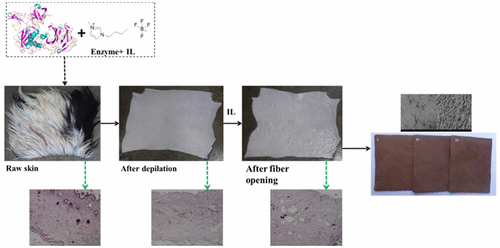Reducing leather pollution with molten salts

From handbags and jackets to car interiors, leather products are almost everywhere. But processing the leather for these luxury items creates a lot of potentially harmful pollution. Now, one group reports in ACS Sustainable Chemistry & Engineering a new method for processing leather that is more eco-friendly.
According to Rolls Royce, it takes 12 cow hides to upholster the interior of one of their automobiles. The journey from cow to a leather seat is a long one, involving many steps. One of the more well-known steps is called tanning, but before that can even happen, hair must be removed from the hides, and the fibers must be "opened" up or swollen. Currently, manufacturers use lime and sodium sulfide to accomplish these steps, but this produces sludge waste and toxic gas, and then it requires ammonium salts to remove the lime. Ionic liquids are molten salts at room temperature and are not very volatile, making them attractive alternatives to harsh substances. These liquids have been investigated for use in leather-making, but they've only been applied to a single process. Jaya Prakash Alla, Jonnalagadda Raghava Rao and Nishter Nishad Fathima wanted to see whether they could completely eliminate the need for lime and sodium sulfide by using ionic liquids in both the hair removal and fiber opening steps.
The team performed three different treatments on goat skins. For the control, the researchers used traditional methods. The second set of skins was processed with a hybrid method (called E1) that involved an enzyme for hair removal and lime for opening fibers. The third treatment (called E2) involved the enzyme and an ionic liquid for hair removal, then the ionic liquid again for fiber opening. The ionic-liquid-treated skins weren't quite as strong as the control after tanning, but they had the right coloration and appearance. The E2 treatment eliminated the use of lime, sodium sulfide and ammonium salts, and it reduced pollution output and treatment time.
More information: Jaya Prakash Alla et al. Integrated Depilation and Fiber Opening Using Aqueous Solution of Ionic Liquid for Leather Processing, ACS Sustainable Chemistry & Engineering (2017). DOI: 10.1021/acssuschemeng.7b01116
Abstract
Pollution from the leather industry is of great concern for tanners worldwide. The unhairing and fiber-opening processes, which contribute the majority of the pollution through the use of sodium sulfide and calcium hydroxide, were replaced in this study by processes using an enzyme and the imidiazolium-based ionic liquid (IL) 1-butyl-3-methylimidazolium tetrafluoroborate. In addition, the deliming process, which is typically applied after liming operations, was completely avoided, eliminating the use of ammonium salts, which leads to other environmental concerns. The extent of fiber opening of the matrix was analyzed by estimating the proteoglycan content and performing histological studies. The physical strength properties of the IL-treated leathers were found to be comparable to standard norms. This study thus demonstrates that ILs can be successfully employed for unhairing, where they can enhance the activity of unhairing enzymes, as well as for the fiber-opening process of leather making
Provided by American Chemical Society


















